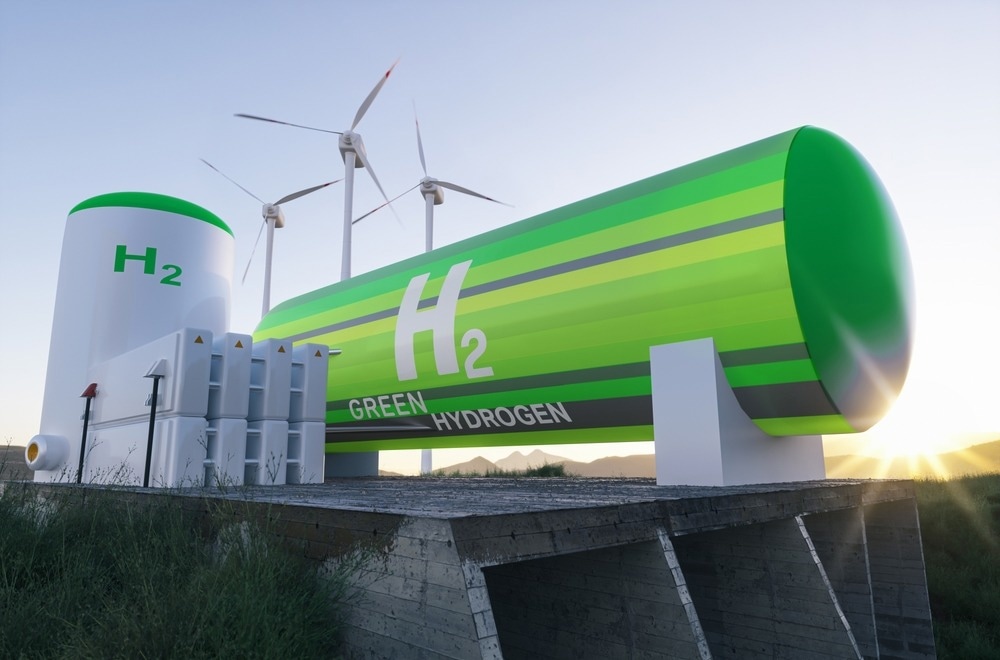Urea electrolysis can create molecular green hydrogen while also addressing the environmental issues posed by urea-rich sewage effluents. However, developing low-cost, extremely reactive, and robust electrocatalysts for highly-efficient urea electrolysis is critical for green hydrogen synthesis.

Study: Porous NiO Nanosheet Bifunctional Electrodes Modified with Ultrafine Ni3S2 Quantum Dots for Green Hydrogen Production via Urea Electrolysis. Image Credit: Audio und werbung/Shutterstock.com
A recent study published in The Journal of Physical Chemistry C focuses on this issue by preparing porous nickel oxide nanosheets decorated with nickel sub-sulfide quantum dots on nickel foam (NiO/Ni3S2/NF) for green hydrogen synthesis.
Green Hydrogen Production: Overview and Challenges
Hydrogen is regarded as an excellent fuel carrier and can be generated by splitting water or separating it from other hydrogen-containing molecules. The production of green hydrogen using electricity provided by sustainable energy resources is a potential and eco-friendly solution to energy storage problems.
The oxygen evolution reaction (OER) and the hydrogen evolution reaction (HER) happen on the anode and cathode, respectively, during the water electrolysis mechanism. Unfortunately, high-performance electrocatalysts are required for water electrolysis because of the slow reaction kinetics of these processes. Platinum group metal (PGM) catalysts are often employed as HER and OER catalysts to reduce conduction losses and accelerate reaction rates.
However, the high cost, unavailability, and limited accessibility of these PGM catalysts substantially limit their industrial applications. As a result, low-cost alternative techniques for decreasing the total cost and power usage of green hydrogen generation are urgently needed.
Green Hydrogen Synthesis via Urea Electrolysis
The rate-determining step (rds) in water electrolysis is the slow oxygen evolution reaction occurring at the anode. Alternate anodic processes with considerably lower potentials are suitable for lowering power usage and creating green hydrogen.
According to relevant research, almost 80% of unprocessed urea-containing sewage effluents are deliberately dumped into the ecosystem each year, and urea nitrate causes significant irreversible ecological contamination. Moreover, the thermal potential of the urea oxidation reaction (UOR) is relatively low, making urea electrolysis for green hydrogen generation favorable since it takes less energy than water splitting.
Green hydrogen generation using urea electrolysis, notably by anodic urea oxidation, has recently been claimed to cut the cost of generated hydrogen by 36%. As a result, large-scale urea electrolysis may be a suitable approach for successfully treating urea-containing wastewater sewage water while producing green hydrogen with minimal energy usage.
Nickel-based Catalysts: The Future of Green Hydrogen Production
Transition metal (TM)-based nanoparticles like TM-based alkalis, oxides, sulfides, and phosphides have recently piqued the interest of researchers owing to their strong catalytic performance toward HER and OER. Nickel (Ni)-based electrocatalysts are the most viable HER and UOR catalyst replacements to PGM-based substances among these TM-based compounds.
Even though Ni-based oxides are excellent candidates for urea electrolysis, their poor conductance, slow charge transport rates, and poor hydrogen absorption severely restrict their catalytic performance. Many investigations have been conducted to increase the catalytic performance of nickel-based oxides by doping metallic cations or other anions into the nickel oxides and generating novel phases on the nickel oxides' surfaces.
This approach alters the 3D architecture of the electrocatalysts, increases surface abrasion, and produces nanoparticles, resulting in better catalytic efficiency. However, these solutions are expensive and make concurrent enhancement of catalyst conductance, active site density, and specific contact area challenging.
Highlights and Key Developments of the Current Study
In this study, permeable nickel oxide (NiO) nanosheets covered with nickel sub-sulfide (Ni3S2) quantum dots (NiO/ Ni3S2/NF) were created as HER and UOR heterogeneous catalysts for urea electrolysis. The permeable architecture was produced on the interface of NiO nanosheets through gas-phase vulcanization, and Ni3S2 quantum dots were generated through the Kirkendall phenomenon.
The nickel oxide catalyst coated with Ni3S2 quantum dots showed excellent catalytic performance and stability in the urea oxidation reaction (UOR) and hydrogen evolution process. The creation of porous materials on NiO nanosheets and the crucial involvement of Ni3S2 quantum dots are credited with the remarkable electrocatalytic activity of the as-prepared NiO/ Ni3S2/NF.
The Ni3S2 quantum dots-modified nickel oxide electrode created in this work exemplifies an innovative approach to designing and producing low-cost, highly productive, and robust electrocatalysts for urea electrolysis.
Reference
Xu, X. et al. (2022). Porous NiO Nanosheet Bifunctional Electrodes Modified with Ultrafine Ni3S2 Quantum Dots for Green Hydrogen Production via Urea Electrolysis. The Journal of Physical Chemistry C. Available at: https://doi.org/10.1021/acs.jpcc.2c06509
Disclaimer: The views expressed here are those of the author expressed in their private capacity and do not necessarily represent the views of AZoM.com Limited T/A AZoNetwork the owner and operator of this website. This disclaimer forms part of the Terms and conditions of use of this website.